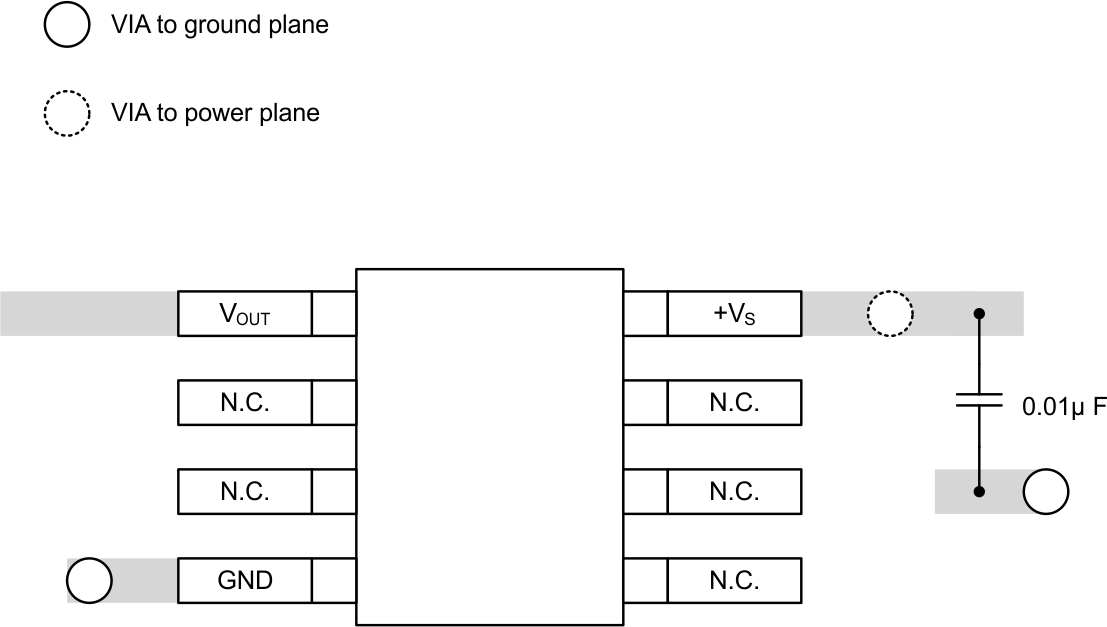SNIS161D March 2000 – January 2016 LM34
PRODUCTION DATA.
- 1 Features
- 2 Applications
- 3 Description
- 4 Revision History
- 5 Pin Configuration and Functions
- 6 Specifications
- 7 Detailed Description
- 8 Application and Implementation
- 9 Power Supply Recommendations
- 10Layout
- 11Device and Documentation Support
- 12Mechanical, Packaging, and Orderable Information
Package Options
Mechanical Data (Package|Pins)
Thermal pad, mechanical data (Package|Pins)
Orderable Information
10 Layout
10.1 Layout Guidelines
The LM34 device can be easily applied in the same way as other integrated-circuit temperature sensors. The device can be glued or cemented to a surface and its temperature will be within about 0.02°F of the surface temperature. This presumes that the ambient air temperature is almost the same as the surface temperature; if the air temperature were much higher or lower than the surface temperature, the actual temperature of the LM34 die would be at an intermediate temperature between the surface temperature and the air temperature. This is especially true for the TO-92 plastic package, where the copper leads are the principal thermal path to carry heat into the device, so its temperature might be closer to the air temperature than to the surface temperature.
To minimize this problem, be sure that the wiring to the LM34, as it leaves the device, is held at the same temperature as the surface of interest. The easiest way to do this is to cover up these wires with a bead of epoxy, which will insure that the leads and wires are all at the same temperature as the surface, and that the die temperature of the LM34 device will not be affected by the air temperature.
The TO-46 metal package can be soldered to a metal surface or pipe without damage. In the case where soldering is used, the V− terminal of the circuit will be grounded to that metal. Alternatively, the LM34 device can be mounted inside a sealed-end metal tube, and can then be dipped into a bath or screwed into a threaded hole in a tank. As with any IC, the LM34 and accompanying wiring and circuits must be kept insulated and dry, to avoid leakage and corrosion. This is especially true if the circuit may operate at cold temperatures where condensation can occur. Printed-circuit coatings and varnishes such as a conformal coating and epoxy paints or dips are often used to insure that moisture cannot corrode the LM34 or its connections.
These devices are sometimes soldered to a small, light-weight heat fin to decrease the thermal time constant and speed up the response in slowly-moving air. On the other hand, a small thermal mass may be added to the sensor to give the steadiest reading despite small deviations in the air temperature.
Table 2. Temperature Rise of LM34 Due to Self-Heating (Thermal Resistance)
| CONDITIONS | TO-46 NO HEAT SINK |
TO-46, SMALL HEAT Fin(1) |
TO-92, NO HEAT SINK |
TO-92, SMALL HEAT Fin(2) |
SO-8 NO HEAT SINK |
SO-8 SMALL HEAT Fin |
|---|---|---|---|---|---|---|
| Still air | 720°F/W | 180°F/W | 324°F/W | 252°F/W | 400°F/W | 200°F/W |
| Moving air | 180°F/W | 72°F/W | 162°F/W | 126°F/W | 190°F/W | 160°F/W |
| Still oil | 180°F/W | 72°F/W | 162°F/W | 126°F/W | — | — |
| Stirred oil | 90°F/W | 54°F/W | 81°F/W | 72°F/W | — | — |
| (Clamped to metal, infinite heart sink) | (43°F/W ) | — | — | (95°F/W ) | ||
10.2 Layout Example
 Figure 28. Layout Example
Figure 28. Layout Example